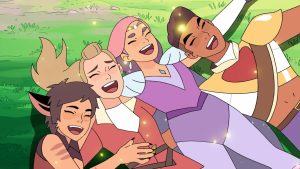How ‘The Legend of Korra’ Revolutionized Queer Representation in Animation
‘The Legend of Korra’, an American animated television series, made a groundbreaking stride in the realm of queer representation in animation. The series, which aired from 2012 to 2014, depicted a complex, layered world filled with diverse characters, each with their own unique traits and stories. However, what truly set ‘The Legend of Korra’ apart was its portrayal of the evolving relationship between the series’ protagonist, Korra, and her friend, Asami. In a realm that had mostly stuck to traditional heteronormative narratives, this was a breath of fresh air.
The show subtly built the connection between the two women over the course of several seasons, never rushing or forcing the narrative. It showed them as friends first, allowing their bond to deepen organically. This slow progression normalized their relationship, showing that it was another facet of their character and not their sole defining feature. This was a marked departure from the often tokenistic representation queer characters had been subjected to in mainstream animation.
By the series finale, ‘The Legend of Korra’ did something rarely seen in mainstream animation – it confirmed a queer relationship. Korra and Asami’s final scene together, where they held hands and looked into each other’s eyes, was a clear indication of their romantic feelings. It was a moment that was poignant and beautiful, while simultaneously groundbreaking.
The creators of the show, Michael Dante DiMartino and Bryan Konietzko, later confirmed the romantic relationship between Korra and Asami. This confirmation was not only a significant step forward for representation in animation but also an affirmation for fans who had seen themselves in the characters and their relationship. It acknowledged that their experiences and identities were valid and deserved to be seen and celebrated.
‘The Legend of Korra’ showed that queer relationships could be portrayed in animation in a nuanced, respectful, and beautiful manner. It demonstrated that these relationships could be an integral part of the narrative, rather than a side note. The show’s approach to queer representation was revolutionary, challenging the industry norms and paving the way for more inclusive storytelling in animation.
Furthermore, the series’ impact extended beyond the show itself. It sparked conversations about the need for greater diversity and representation in animation. It encouraged other creators to include more diverse characters and narratives in their work, contributing to a shift in the industry.
In conclusion, ‘The Legend of Korra’ played a pivotal role in revolutionizing queer representation in animation. It took a genre that had long been dominated by heteronormative narratives and introduced a queer love story that was complex, respectful, and beautifully told. The series broke barriers, challenged norms, and paved the way for more inclusive storytelling in the world of animation. It showed that queer stories could be told in any medium and made a significant impact on the industry as a whole.

The Groundbreaking Moments: Key Changes in Queer Representation
The progression of Queer representation in society has been marked by several groundbreaking moments, each playing a significant role in shifting perceptions and opening up new spaces for discussions about sexuality and gender identity. The Stonewall riots in 1969 acted as a catalyst for the LGBTQ+ rights movement, sparking a global shift towards greater acceptance and understanding. In the media, the 1990s saw a gradual increase in queer characters being portrayed in a positive light, notably with shows like “Ellen” and “Will & Grace” breaking barriers on mainstream television. Hollywood too, began to confront its own stereotypes with films like “Brokeback Mountain” and “Milk” challenging the heteronormative narrative. The digital age further amplified Queer voices with platforms such as YouTube, Tumblr, and Twitter providing a haven for young LGBTQ+ individuals to share their experiences and find community. More recently, shows like “Orange is the New Black”, “Pose”, and “Euphoria” have been lauded for their diverse and complex representation of Queer identities. Meanwhile, in literature, works like “Call Me By Your Name” and “Simon vs. the Homo Sapiens Agenda” offer nuanced portrayals of Queer love and identity. The advent of Queer studies in academia has also significantly contributed to the conversation, challenging traditional notions of gender and sexuality. Each of these key changes represents a significant step forward in the journey towards greater Queer representation and acceptance. Despite the progress made, the fight for comprehensive and accurate representation continues, as many in the LGBTQ+ community still face discrimination and misrepresentation. To continue this progress, it is essential to support diverse voices within the Queer community, ensuring their stories are told and their experiences are validated.
Behind the Scenes: The Creative Forces Driving LGBTQ+ Inclusivity
Behind the Scenes: The Creative Forces Driving LGBTQ+ Inclusivity is an expansive topic that delves into the strategies and efforts employed to foster acceptance and understanding of the LGBTQ+ community. This sphere of discussion is heavily influenced by the creative industries, such as film, television, music, and literature, where LGBTQ+ narratives are becoming increasingly prominent. These industries are instrumental in shaping societal perceptions and attitudes, and the increased representation of diverse sexual orientations and gender identities contributes significantly to normalizing LGBTQ+ experiences and promoting inclusivity.
Creative forces from all corners of the world are pushing the boundaries, striving to depict LGBTQ+ lives authentically and respectfully. The involvement of LGBTQ+ individuals in the creation process is paramount in ensuring genuine representation. From scriptwriters to directors, actors to producers, the presence of queer voices behind the scenes is critical. Their lived experiences provide a deeper understanding and nuanced portrayal of LGBTQ+ characters and narratives, challenging stereotypes and misconceptions.
Moreover, social media platforms and digital content creators are playing a pivotal role in driving LGBTQ+ inclusivity. They provide a platform for queer voices to share their stories, experiences, and perspectives, fostering a sense of community and mutual understanding. Moreover, brands and corporations are also contributing to the conversation by promoting diversity in their marketing strategies and corporate culture.
However, the journey towards total inclusivity is still far from over. While there has been significant progress, there is still a need for more authentic and diverse representation across all facets of the creative industry. This includes not only representation of varied sexual orientations and gender identities, but also intersectionality within the LGBTQ+ community, acknowledging and representing the experiences of individuals who identify with multiple marginalized groups. Through continued efforts from these creative forces, the goal of achieving a more inclusive society where everyone feels seen, heard, and valued becomes increasingly attainable.

Comparing Queer Representation in ‘The Legend of Korra’ and Other Shows
In the landscape of animation, ‘The Legend of Korra’ has been a game-changer for queer representation. Its central character, Korra, embarks on a romantic relationship with another female character, Asami, marking a significant achievement for LGBTQ+ representation in the animation genre. Other shows have also attempted to portray queer representation, but their approach and depth differ significantly. For instance, ‘Steven Universe’ has been lauded for its portrayal of non-binary and lesbian characters, with relationships that are organically woven into the narrative, much like in ‘The Legend of Korra’. However, shows like ‘Adventure Time’ have been less explicit, hinting at queer relationships through subtext and only confirming them towards the end of the series. Contrarily, ‘She-Ra and the Princesses of Power’ has been unapologetically queer from the onset, with multiple LGBTQ+ characters and relationships. While ‘The Legend of Korra’ broke barriers by showcasing a same-sex relationship in a mainstream animated series, it was not without controversy due to the subtlety of the relationship until the series finale. Comparatively, other shows have been more overt in their representation, creating a more inclusive narrative. This comparison illustrates the evolving nature of queer representation in animation, highlighting the progress made, but also the challenges that persist. ‘The Legend of Korra’ stands as a pioneer, paving the way for other shows to follow suit and continue pushing boundaries in the representation of diverse relationships. It is a testament to the gradual but determined shift towards a more inclusive and representative animation industry.
Reflections on the Legacy of ‘The Legend of Korra’
As we reflect on the legacy of ‘The Legend of Korra’, the impact of this groundbreaking animated series cannot be overstated. This sequel to ‘Avatar: The Last Airbender’ not only continued the intricate world-building and high-stakes adventure of its predecessor, but also pushed the boundaries of what was traditionally acceptable in children’s programming. The titular character, Korra, is a strong, independent woman of color – a rarity in the landscape of mainstream animation. The series also dared to delve into complex themes such as PTSD, authoritarianism, and identity, offering nuanced commentary that was both enlightening and thought-provoking.
Perhaps most significantly, ‘The Legend of Korra’ made history with its bold portrayal of LGBTQ+ representation. The romantic relationship between Korra and Asami was handled with care and sensitivity, becoming a beacon of representation for many viewers. This progressive narrative choice was not merely tacked on, but rather, it was woven into the fabric of the characters’ development throughout the series, which made it all the more impactful.
Furthermore, the series’ commitment to portraying diverse cultures and fighting systems, all inspired by real-world counterparts, added a layer of authenticity that resonated with audiences. Its exploration of the balance between technology and nature, tradition and progress, individualism and community, were not only entertaining but also meaningful.
In conclusion, ‘The Legend of Korra’ has left a significant legacy that goes beyond the confines of the animated world. It has set a high bar for future children’s programming, proving that shows aimed at younger audiences can tackle complex themes and promote inclusivity without compromising on entertainment value. It is a testament to the transformative power of storytelling, and its influence will undoubtedly be felt for generations to come.

Future Directions for Queer Representation in Animation
Future directions for queer representation in animation are likely to evolve in a direction of greater inclusivity and visibility. As the societal understanding and acceptance of the LGBTQ+ community expands, there is an increasing demand for authentic representation within all forms of media, animation included. The importance of this representation can’t be overstated, as it provides LGBTQ+ individuals, particularly the youth, with relatable characters and narratives that reflect their experiences, struggles, and triumphs.
The future of queer representation in animation promises to break new grounds by moving beyond token characters or secondary roles. There is a growing trend towards developing main characters in animated series who identify as LGBTQ+. This not only challenges the traditional heteronormative narrative but also allows for more nuanced and complex storytelling.
Moreover, animation studios are now more conscious about the need to involve queer creators in the development process. This approach ensures the authenticity of representation, as these creators bring their lived experiences to the drawing board. This also provides an opportunity for a wide range of LGBTQ+ stories to be told, moving beyond simplistic or stereotypical depictions.
The rise of streaming platforms also plays a significant role in this new direction. With more freedom than traditional television networks, these platforms are able to produce content that is more diverse and inclusive. The success of animated series featuring queer characters on these platforms is a testament to the audience’s readiness for such content.
However, there remains a significant amount of work to be done. Despite recent advancements, queer representation in animation is still not proportional to the presence of LGBTQ+ individuals in society. In addition, the representation across the entire spectrum of LGBTQ+ identities is still lacking, with certain identities being more represented than others. The future of queer representation in animation will hopefully address these gaps and continue to push boundaries, ensuring all members of the LGBTQ+ community see themselves reflected on screen.
